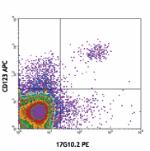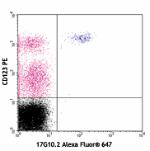- Clone
- 17G10.2 (See other available formats)
- Regulatory Status
- RUO
- Other Names
- CD85g, immunoglobulin-like transcript 7, LILRA4
- Isotype
- Mouse IgG1, κ
| Cat # | Size | Price | Quantity | |||
|---|---|---|---|---|---|---|
| 285033 | 50 µg | $375.00 | ||||
ILT7 (immunoglobulin-like transcript 7) is a member of leukocyte immunoglobulin-like receptor (LIR or LILR) gene family, also known as CD85g and LILRA4. It contains four extracellular Ig domains. In association with FcεR1γ, ILT7 forms a receptor complex that transduces ITAM-mediated signals. ILT7 is specifically expressed on plasmacytoid dendritic cells (pDCs), but not on myeloid dendritic cells and other peripheral blood leukocytes. ILT7 negatively regulates the innate immune functions of human pDCs. Cross-linking 17G10.2 antibody is able to trigger ILT7 mediated signaling.
Product Details
- Verified Reactivity
- Human
- Antibody Type
- Monoclonal
- Host Species
- Mouse
- Formulation
- Phosphate-buffered solution, pH 7.2, containing 0.09% sodium azide
- Preparation
- The antibody was purified by affinity chromatography and conjugated with Spark Red™ 718 under optimal conditions.
- Concentration
- 0.2 mg/mL
- Storage & Handling
- The antibody solution should be stored undiluted between 2°C and 8°C, and protected from prolonged exposure to light. Do not freeze.
- Application
-
FC
- Recommended Usage
-
Flexi-Fluors™ are provided at a standard 0.2 mg/mL concentration. We recommend titrating this reagent to determine the optimal concentration for each application. For many flow cytometry applications, conjugated antibodies perform well at concentrations ranging from 0.03 to 1.0 µg per million cells in 100 µL. We recommend testing a range of concentrations starting from 10 µg/mL.
For example, make five 1:1 serial dilutions of the 0.2 mg/mL antibody. Add 5 µL of each dilution (including the undiluted antibody) to 100 µL of cells (at 107 cells/mL) to test six concentrations -- 1.0, 0.5, 0.25, 0.125, 0.06, and 0.03 µg per million cells in 100 µL volume. Compare staining patterns or create a titration curve using the MFI or staining index to determine the optimal concentration. - Excitation Laser
-
Red Laser (633 nm)
- Application Notes
-
Additional reported (for the relevant formats) applications include: trigger ILT7 mediated signaling.The Ultra-LEAF™ purified antibody (Endotoxin < 0.01 EU/µg, Azide-Free, 0.2 µm filtered) is recommended for functional assays (Cat. No. 326413 and 326414).
- Additional Product Notes
-
For more information about Flexi-Fluors™, visit our Flexi-Fluor™ page and review FAQs associated with this product line.
-
Application References
(PubMed link indicates BioLegend citation) -
- Jensen MA, et al. 2013. Ann Rheum Dis. 72:596. PubMed.
- RRID
-
AB_3106298 (BioLegend Cat. No. 285033)
Antigen Details
- Structure
- Associate with FcεR1γ leukocyte immunoglobulin-like receptor gene family
- Distribution
-
Plasmacytoid dendritic cells
- Function
- Negatively regulates pDC mediated innate immune function
- Cell Type
- Dendritic cells
- Biology Area
- Immunology, Innate Immunity
- Molecular Family
- CD Molecules
- Antigen References
-
1. Cao W, et al. 2006. J. Exp. Med. 203(6):1399.
2. Brown D, et al. 2004. Tissue Antigen. 64:215.
3. Rissoan MC, et al. 2002. Blood 100:3295. - Gene ID
- 23547 View all products for this Gene ID
- UniProt
- View information about CD85g on UniProt.org
Other Formats
View All CD85g (ILT7) Reagents Request Custom Conjugation| Description | Clone | Applications |
|---|---|---|
| PE anti-human CD85g (ILT7) | 17G10.2 | FC |
| Alexa Fluor® 647 anti-human CD85g (ILT7) | 17G10.2 | FC |
| Ultra-LEAF™ Purified anti-human CD85g (ILT7) | 17G10.2 | FC,FA |
| TotalSeq™-C0409 anti-human CD85g (ILT7) | 17G10.2 | PG |
| TotalSeq™-B0409 anti-human CD85g (ILT7) | 17G10.2 | PG |
| Brilliant Violet 421™ anti-human CD85g (ILT7) | 17G10.2 | FC |
| Spark Red™ 718 anti-human CD85g (ILT7) (Flexi-Fluor™) | 17G10.2 | FC |
Compare Data Across All Formats
This data display is provided for general comparisons between formats.
Your actual data may vary due to variations in samples, target cells, instruments and their settings, staining conditions, and other factors.
If you need assistance with selecting the best format contact our expert technical support team.
-
PE anti-human CD85g (ILT7)

CD14- human peripheral blood mononuclear cells st... -
Alexa Fluor® 647 anti-human CD85g (ILT7)

Human peripheral blood mononuclear cells stained with CD123 ... -
Ultra-LEAF™ Purified anti-human CD85g (ILT7)
-
TotalSeq™-C0409 anti-human CD85g (ILT7)
-
TotalSeq™-B0409 anti-human CD85g (ILT7)
-
Brilliant Violet 421™ anti-human CD85g (ILT7)

Human peripheral blood mononuclear cells were stained with a... -
Spark Red™ 718 anti-human CD85g (ILT7) (Flexi-Fluor™)
